

Gathering Seagrass or Using the "The Beast"
![]()
Objective: To obtain samples of the sea floor for biomass processing.
Biomass samples are collected from the sea floor so that they can be processed
once back at the research camp. Collecting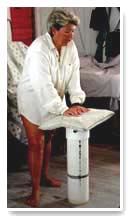 biomass from the sea floor takes strong swimmers, quadrats, floaters, and
a device affectionately called “The Beast”.
biomass from the sea floor takes strong swimmers, quadrats, floaters, and
a device affectionately called “The Beast”.
Quadrats are PVC plastic squares approximately one foot square. There are
four of them and each one is divided into four equal sections and labeled:
A, B, C, and D. When a biomass sample is to be taken the boat anchors in
the predetermined location. The quadrats are tossed off the plot in each
of the four cardinal directions: North, South, East, and West. The quadrats
each have a floater, or a small plastic bottle, attached to them with a
string. These floaters mark the locations of the quadrats so that the divers
on the surface can find them.
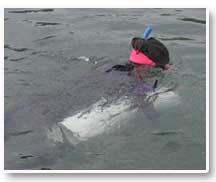 Next,
at least three divers suit up in snorkel gear and get in the water. Once
in the water, the divers anchor the quadrats to the sea floor with rebar
poles that are stuck into sections B and D of the quadrats to keep them
stationary.
Next,
at least three divers suit up in snorkel gear and get in the water. Once
in the water, the divers anchor the quadrats to the sea floor with rebar
poles that are stuck into sections B and D of the quadrats to keep them
stationary.
“The Beast” is then handed to the divers over the side of the
boat. The beast is a two foot long, six inch diameter piece of PVC pipe
with a threaded lid and a piece of rebar in it that serves as a handle.
The divers are also handed a bright pink mesh bag and a floatation cushion
from the boat.
The divers then swim out to one of the quadrats with the Beast, the mesh
bag and the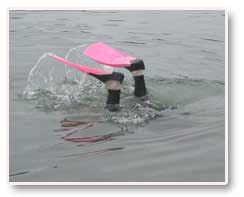 floatation cushion. One person grabs the handle of the beast, does a deep
dive, and carefully aims for section A of the quadrat. The beast is forced
about a foot into the ocean floor. Sometimes, however, the floor is so hard
that the diver has to jump on the handles to force it into the sea floor—no
easy task in the water while holding one’s breath.
floatation cushion. One person grabs the handle of the beast, does a deep
dive, and carefully aims for section A of the quadrat. The beast is forced
about a foot into the ocean floor. Sometimes, however, the floor is so hard
that the diver has to jump on the handles to force it into the sea floor—no
easy task in the water while holding one’s breath.
After the Beast is securely in place the divers take a brief rest on the
sea surface for a minute or so as now they must begin the process of pulling
the Beast and its core sample from the sea floor. To accomplish this, one
diver dives down and screws the cover onto the beast while it is still in
the sea floor. This creates suction so that the sediment does not come out
when the Beast is removed. The diver then begins to wrestle it from the
ground while the other divers watch from the surface. This can take a few
tries and the water becomes very murky from the disturbance on the bottom
making it difficult for the other team members to see.
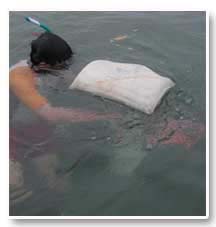 As
soon as the Beast is removed the person with the floatation cushion and
the person with the mesh bag move in simultaneously to assist. The sample
is very heavy so the person with the cushion grabs the handles of the beast
and places them into the straps of the floatation cushion to help relieve
some of the weight and help the first team member get to the surface. At
the same time, the remaining diver dives down and places the mesh bag over
the bottom of the beast. Once the bag is securely in
As
soon as the Beast is removed the person with the floatation cushion and
the person with the mesh bag move in simultaneously to assist. The sample
is very heavy so the person with the cushion grabs the handles of the beast
and places them into the straps of the floatation cushion to help relieve
some of the weight and help the first team member get to the surface. At
the same time, the remaining diver dives down and places the mesh bag over
the bottom of the beast. Once the bag is securely in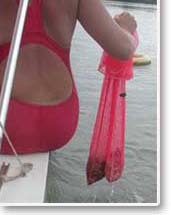 place, the lid is then unscrewed. This along with shaking and banging the
Beast forces the sample to fall into the mesh bag.
place, the lid is then unscrewed. This along with shaking and banging the
Beast forces the sample to fall into the mesh bag.
The sample is then quickly taken to the boat by one of the divers and another
bag is retrieved. The process is repeated until a core is obtained from
all four quadrats. On the boat, another person repeatedly shakes the sample
in the water to wash away any mud. Once the sample is free of mud, it is
placed into a labeled zip-lock bag to be taken back to camp for biomass
processing.
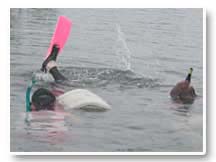 While
this all sounds quite orderly, it looks like utter chaos to observers on
the boat. All that can be seen is a group of divers with some pretty funny
equipment thrashing about in the water. It almost looks like a group of
animals during a feeding frenzy!
While
this all sounds quite orderly, it looks like utter chaos to observers on
the boat. All that can be seen is a group of divers with some pretty funny
equipment thrashing about in the water. It almost looks like a group of
animals during a feeding frenzy!